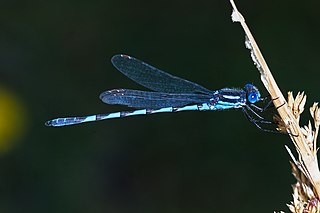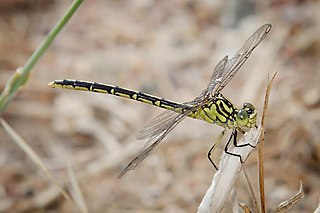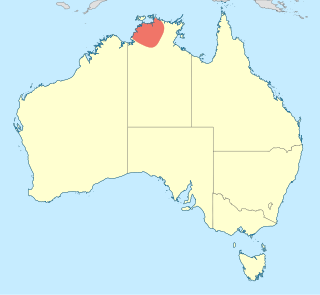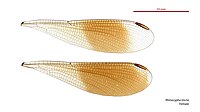
Tramea is a genus of dragonflies in the family Libellulidae, the skimmers and perchers. Species of Tramea are found in tropical and subtropical regions around the globe. They typically have colored bases to their otherwise translucent hindwings. In particular when they fly, this creates the impression of their carrying bags at the start of their abdomens. They are known commonly as saddlebags or saddlebags gliders.

The blue riverdamsel, Pseudagrion microcephalum is a common species of damselfly in the family Coenagrionidae. It is also known as the blue sprite and blue grass dart.

Austrolestes is a genus of medium to large-sized damselflies in the family Lestidae. Austrolestes dragonflies sit with their wings folded completely back. Males are usually bright blue and black, the females duller. Members of this genus are found in Australia, New Zealand and South Pacific islands.

Diplacodes trivialis is a species of dragonfly in the family Libellulidae known as the chalky percher or ground skimmer. It is found in China, Japan, India and southwards to New Guinea and Australia.

The Australian emerald is a species of dragonfly in the family Corduliidae. It can be found in Australia, Lord Howe Island, Norfolk Island, Lesser Sunda Islands and New Zealand. It is a small to medium-sized, long-legged dragonfly coloured black-metallic and yellow. In both males and females the inboard edge of the hindwing is rounded.

Rhyothemis graphiptera, known as the graphic flutterer or banded flutterer, is a species of dragonfly of the family Libellulidae. It is found across northern Australia, the Moluccas, New Guinea and New Caledonia. Rhyothemis extends from Africa to the western Pacific.

Agriocnemis pygmaea is a species of damselfly in the family Coenagrionidae. It is also known as wandering midget, pygmy dartlet or wandering wisp. It is well distributed across Asia and parts of Australia.

Zyxomma petiolatum, known by the common names long-tailed duskdarter, brown dusk hawk and dingy duskflyer, is a species of dragonfly in the family Libellulidae. It is widespread in many Asian countries,, New Guinea, northern Australia and islands in the Pacific.

Procordulia jacksoniensis is a species of dragonfly in the family Corduliidae, known as the eastern swamp emerald. It inhabits rivers, pools and lakes in eastern Australia, from Brisbane through New South Wales, Victoria and Tasmania, and around Adelaide in South Australia.

Anax gibbosulus is a species of large dragonfly of the family Aeshnidae, commonly known as the green emperor. It inhabits swamps and brackish waters from India through northern Australia to the Pacific.

Austrogomphus guerini, also known as Austrogomphus (Austrogomphus) guerini, is a species of dragonfly of the family Gomphidae, commonly known as the yellow-striped hunter. It inhabits streams, rivers and lakes in eastern New South Wales, Victoria and Tasmania, Australia.

Neurobasis australis is a species of damselfly in the family Calopterygidae, commonly known as a Papuan demoiselle. It is a large, metallic green damselfly with long legs, and dark wings without pterostigma. It has been recorded from New Guinea, and Indonesia, where it inhabits streams.

Aciagrion fragilis is a species of damselfly in the family Coenagrionidae, commonly known as a blue slim. It is a small, slender damselfly, the male is blue and black. It has been recorded from northern Australia, New Guinea and the Lesser Sunda Islands in Indonesia, where it inhabits still waters and swamps.

Agriocnemis rubricauda is a species of Australian damselfly in the family Coenagrionidae, commonly known as a red-rumped wisp. It is a small damselfly; the male has a red end to his tail. It has been recorded from northern Australia where it inhabits boggy seepages and swamps.

Archibasis mimetes is a species of damselfly in the family Coenagrionidae, commonly known as a blue-banded longtail. It is a medium-sized damselfly; the male is bright blue and black. It has been recorded from New Guinea and northern Australia, where it inhabits streams.

Austroagrion exclamationis is a species of damselfly in the family Coenagrionidae, commonly known as a northern billabongfly. It is a small damselfly; the male is blue and black. It has been recorded from New Guinea and northern Australia, where it inhabits streams and still water.

Eurysticta kununurra is a species of damselfly in the family Isostictidae, commonly known as a Kimberley pin. It has been recorded in the Kimberley region in Western Australia, where it inhabits rivers.

Nososticta baroalba is a species of Australian damselfly in the family Platycnemididae, commonly known as a black-winged threadtail. It has only been found in the Northern Territory, where it inhabits streams.

Nososticta koolpinyah is a species of Australian damselfly in the family Platycnemididae, commonly known as a Koolpinyah threadtail. It has only been found in the vicinity of Darwin and on Melville Island in Northern Territory, where it inhabits streams.

Nososticta koongarra is a species of Australian damselfly in the family Platycnemididae, commonly known as a citrine threadtail. It has only been found on the Arnhem Land escarpment in Northern Territory, where it inhabits streams.























